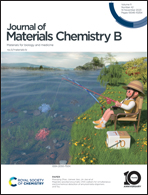Effect of molar mass and alkyl chain length on the surface properties and biocompatibility of poly(alkylene terephthalate)s for potential cardiovascular applications†
Abstract
Cardiovascular diseases are the leading cause of death worldwide. Treatments for occluded arteries include balloon angioplasty with or without stenting and bypass grafting surgery. Poly(ethylene terephthalate) is frequently used as a vascular graft material, but its high stiffness leads to compliance mismatch with the human blood vessels, resulting in altered hemodynamics, thrombus formation and graft failure. Poly(alkylene terephthalate)s (PATs) with longer alkyl chain lengths hold great potential for improving the compliance. In this work, the effect of the polymer molar mass and the alkyl chain length on the surface roughness and wettability of spin-coated PAT films was investigated, as well as the endothelial cell adhesion and proliferation on these samples. We found that surface roughness generally increases with increasing molar mass and alkyl chain length, while no trend for the wettability could be observed. All investigated PATs are non-cytotoxic and support endothelial cell adhesion and growth. For some PATs, the endothelial cells even reorganized into a tubular-like structure, suggesting angiogenic maturation. In conclusion, this research demonstrates the biocompatibility of PATs and their potential to be applied as materials serving cardiovascular applications.



 Please wait while we load your content...
Please wait while we load your content...